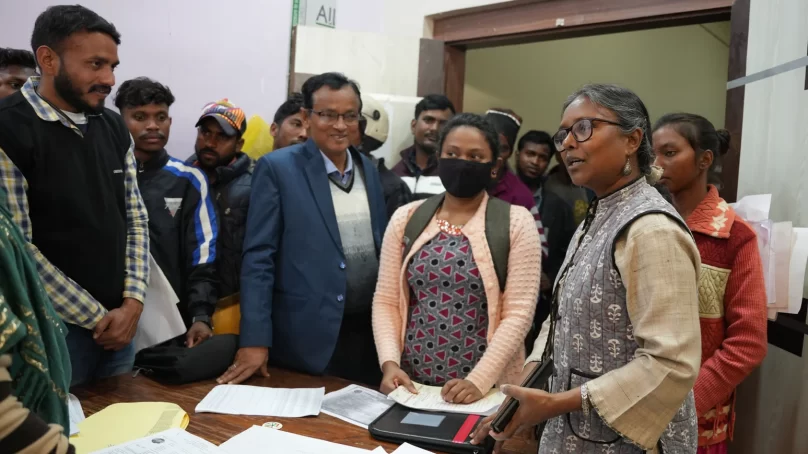
Some premier institutes in India are doing a little better when it comes to access to education for all castes. At the Council of Scientific and Industrial Research, a group of 38 labs, 18 per cent of researchers (combining senior staff grades) were Dalits and 4 per cent Adivasis, according to data Nature received from 31 of those labs.
Most of India’s research funders don’t disclose data on funding by caste, or don’t collect them in the first place. But the Department of Science and Technology (DST), one of India’s two main science-funding government agencies, did share data with Nature on postdoctoral researchers whom it had awarded INSPIRE Faculty Fellowships – positions aimed at supporting young talent, which represent an important but small part of the DST’s total funding.
Between 2016 and 2020, 80 per cent of recipients were from privileged castes, just 6 per cent were Scheduled Castes (Dalits) and less than 1 per cent Scheduled Tribes (Adivasis). The DST says the selection was “strictly based on merit”. Funding given by the DST’s Technology Development and Transfer Division showed a similar pattern. In both cases, the DST didn’t share application success rates.
Data on two funding schemes, shared with Nature by India’s Department of Science and Technology (DST) under information requests, suggest most money goes to researchers from privileged castes or groups.
In the past few years, groups of activists, students and researchers have been pushing institutions not only to follow quotas but also to better support researchers from underprivileged communities. “We are doing this to hold a mirror to these institutes to show how ugly they are,” says a spokesperson for Egalitarians, an organisation that tries to collect and publish diversity data.
The issue is part of a wider recognition of how privileged-caste groups have been discriminating against marginalised communities – emboldened by India’s pro-Hindu prime minister Narendra Modi, say some academics who spoke to Nature but did not want their names on record.
Some minority religious groups in India, such as Muslims – who are present across a variety of social and caste divisions, including Dalits – also face structural inequities in society. According to the 2011 census, Muslims make up around 14 per cent of the country’s population, but only 5.5 per cent of those enrolled in higher education in 2019-20 were Muslims, survey data suggest.
Because no more detailed data were available, Nature asked IITs and other institutes for figures to do with Muslim representation. Most replied that they didn’t have the figures, but the sparse data that a few institutions shared suggest that Muslims are under-represented in elite academic institutes.
In 2020, Muslims made up less than 5 per cent of PhD students in IIT Madras in Chennai and less than 1 per cent of science-teaching faculty in IIT Kharagpur; both are prestigious institutes. However, in IIT Dhanbad, a mid-ranking institute in a region where Muslims are not unusually numerous, 55 per cent of PhD students were Muslims.
The rising criticism of under-representation and discrimination in academic institutions, particularly around caste, is prodding some institutes into action. India’s Ministry of Education, which didn’t respond to Nature’s request for an interview, has several times since 2019 told federally funded institutes, including the IITs, to comply with reservation norms when recruiting teachers.
In 2019, Modi’s government expanded the reservation quotas by 10 per cent to cover lower-income people not part of marginalised castes or groups, who would otherwise fall in the ‘General’ category; they would be categorised under ‘Economically Weaker Sections’ of society.
The extension is controversial but, after legal challenges, was upheld in a November 2022 ruling by India’s Supreme Court.
Representatives at four IITs talked on record to Nature for this story; others didn’t respond. “Equating under-representation with discrimination is incorrect. There is no discrimination,” said Neela Nataraj, a mathematician and dean of faculty affairs at IIT Bombay in Mumbai. She accepted that the institute had a shortage of students and faculty members from some social categories, but said it was on a mission to improve representation through recruitment without compromising on quality, and through encouraging more students from under-represented communities to start PhDs.
Angelie Multani, a professor of literature who was appointed in August 2022 as IIT Delhi’s first dean to increase diversity on campus, says the institute recognised that, like others, it had “under-representation of marginalised sections of society” and was working to improve the situation through measures such as hiring drives.
And Amalendu Chandra, dean of faculty affairs at IIT Kanpur, says that the institute had offered appointments to 48 teachers from marginalised communities in the past year.
The institute has 413 faculty members, according to its website.
At IIT Goa, Amaldev Manuel, a computer scientist and chair of PhD admissions in 2022, noted that the institution’s acceptance rate for PhD applicants from marginalised communities was higher (at above 1 per cent) than for the ‘general’ category (below 1 per cent), even though it received fewer applications from people of less privileged castes.
Some researchers, such as Ramesh Chandra, doubt that diversity initiatives by institutions will make a big dent until India’s government takes action against institutes for violating reservation policies. “You have to take punitive action against the [institutes’] directors,” says Chandra. “Remove them.”
At the very least, says Ram, the government should require universities to publicly disclose diversity data and monitor compliance. And Minz thinks that for the situation to change, support systems need to be created at every step from school education to high-level recruitments in academia – such as training on grant-proposal-writing and communication skills for researchers recruited from marginalized communities. “The playing field is not equal at any stage,” she says.
For Samadhan, the marker of change would be more personal. “The day I would be able to say my full name without hesitation in an institute, I will feel that equality has arrived,” he says.
- A Nature report











